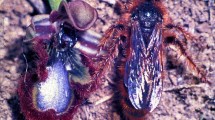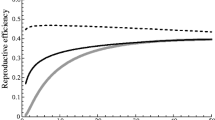Abstract
Pollination interactions are common, and their maintenance is critical for many food crops upon which human populations depend. Pollination is a mutualism interaction; together with predation and competition, mutualism makes up the triumvirate of fundamental interactions that control population dynamics. Here we examine pollination interactions (nectar reward for gamete transport service) using a simple heuristic model similar to the Lotka–Volterra models that have underpinned our understanding of predation and competition so effectively since the 1920s. We use a genetic algorithm to simulate the eco-evolutionary interactions of the plant and pollinator populations and examine the distributions of the parameter values and zero isoclines to infer the relative ubiquity of the various eco-evolutionary outcomes possible in the model. Our results suggest that trade-offs between costs and benefits for the pollinator may be a key component of obligate pollination systems in achieving adaptive success creating and stably occupying mutualist niches.




Similar content being viewed by others
References
Allee WC, Bowen ES (1932) Studies in animal aggregations: mass protection against colloidal silver among goldfishes. J Exp Biol 61:185–207
Bascompte J, Jordano P, Melia CJ, Olesen JM (2003) The nested assembly of plant? Animal mutualistic networks. PNAS 100(16):9383–9387
Bascompte J, Jordano P, Olesen JM (2006) Asymmetric coevolutionary networks facilitate biodiversity maintenance. Science 312:431–433
Boucher DH (1985) The biology of mutualism. Croom Helm, London
Bronstein JL (2015) Mutualism. Oxford University Press, New York
Cropp RA, Norbury J (2015) Population interactions in ecology: a rule-based approach to modelling ecosystems in a mass-conserving framework. SIAM Rev 57:437–465
Dawkins R (1976) The selfish gene. Oxford University Press, Oxford
Dean AM (1983) A simple model of mutualism. Am Nat 121:409–417
DeAngelis DL (1980) Energy flow, nutrient cycling and ecosystem resilience. Ecology 61:764–771
de Mazancourt C, Loreau M, Dieckmann U (2001) Can the evolution of plant defense lead to plant-herbivore mutualism. Am Nat 158(2):109–123
Dubois DM (1998) Emergence of chaos in evolving Volterra ecosystems. In: Van de Vijver G, Salthe SN, Delpos M (eds) Evolutionary systems: biological and epistomological perspectives on selection and self-organisation. Springer, Dordrecht, pp 197–215
Graves WG, Peckham B, Pastor J (2006) A bifurcation analysis of a differential equations model for mutualism. Bull Math Biol 68:1851–1872
Holland JH (1975) Adaptation in natural and artificial systems. University of Michigan Press, Ann Arbour
Holland JN, DeAngelis DL (2010) A consumer-resource approach to the density-dependent population dynamics of mutualism. Ecology 91:1286–1295
Jorgensen SE, Mejer HF (1983) Trends in ecological modelling. In: Lauenroth WK, Skogerboe GV, Flug M (eds) Analysis of ecological systems: state-of-the-art in ecological modelling. Elsevier, Amsterdam, pp 21–26
Levin S (2012) The Princeton guide to ecology. Princeton University Press, Oxford
Lotka AJ (1925) Elements of physical biology. Wilkins and Kilkins, Baltimore
MacArthur RH (1970) Species packing and competitive equilibria for many species. Theor Popul Biol 1:1–11
May RM (1981) Theoretical ecology: principles and applications. Blackwell, Princeton
Mitchell M (1997) An introduction to genetic algorithms. MIT Press, Cambridge
Molles M (2014) Ecology: concepts and applications. McGraw-Hill Education, New York
Murray JD (2001) Mathematical biology. Interdisciplinary applied mathematics, vol 17. Springer, Berlin
Ricklefs RE, Relyea R (2014) Ecology: the economy of nature. W.H. Freeman, New York
Rockwood LL (2015) Introduction to population ecology. Wiley-Blackwell, Oxford
Shimizu A, Dohzono I, Nakaji M, Roff DA, Miller D, Osata S, Yajima T, Niitsu S, Utsugi N, Sugawara T, Yoshinura J (2013) Fine-tuned bee-flower coevolutionary state hidden within multiple pollination interactions. Sci Rep 4:3988. https://doi.org/10.1038/srep03988
Van der Meer JH, Goldberg DE (2013) Population ecology: first principles. Princeton University Press, Woodstock
Vitousek PM, Matson PA (2012) Nutrient cycling and biogeochemistry. In: Levin S (ed) The Princeton guide to ecology. Princeton University Press, New Jersey, pp 330–339
Volterra V (1926) Variations and fluctuations of the numbers of individuals in animal species living together. In: Chapman RN (ed) Reprinted in 1931 in Chapman RN (ed) Animal Ecology. McGraw Hill, New York
Watson RA, Szathmary E (2016) How can evolution learn? Trends Ecol Evol 131:147–157
Wilmer P (2011) Pollination and floral ecology. Princeton University Press, Princeton
Zahran HH (1999) Rhizobium–Legume symbiosis and nitrogen fixation under severe conditions and in an arid climate. Microbiol Mol Biol Rev 63(4):968–989
Acknowledgements
The authors wish to thank Dr. Andrew Morozov and the organisers of the organisers of the Modelling Biological Evolution 2017: Developing Novel Approaches International Conference held at the University of Leicester in April 2017. Funding was provided by Mathematical Institute University of Oxford, Lincoln College, University of Oxford and St. Hilda’s College, University of Oxford.
Author information
Authors and Affiliations
Corresponding author
Electronic supplementary material
Below is the link to the electronic supplementary material.
Rights and permissions
About this article
Cite this article
Cropp, R., Norbury, J. Simulating Eco-evolutionary Processes in an Obligate Pollination Model with a Genetic Algorithm. Bull Math Biol 81, 4803–4820 (2019). https://doi.org/10.1007/s11538-018-0508-1
Received:
Accepted:
Published:
Issue Date:
DOI: https://doi.org/10.1007/s11538-018-0508-1




